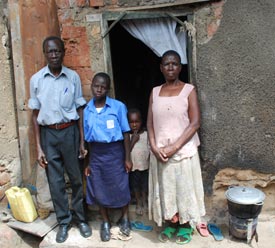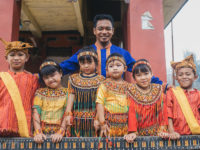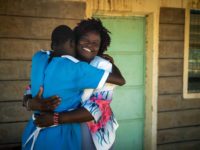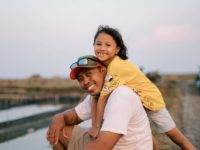In Uganda, the name “Makerere” is synonymous with Uganda’s oldest and most prestigious institute of higher learning: Makerere University. The university sits on Makerere Hill and is not only revered for its students’ academic proficiency and health education, but also for the spacious, manicured lawns and modern buildings that constitute this seat of learning.
In the slum community of Makerere Kivulu that lies in the shadow of this prominent institute, the storm drains overflow with filth and stinking water between rows of shacks made of planks and rusty iron sheets. The dilapidation of these structures is set off by the stable buildings surrounded by high stone walls that dot the area.
Many of the people in the community are unemployed, and even those who are employed are underemployed, dealing in small businesses like hawking goods, frying and roasting food like cassava, and selling vegetables like tomatoes and eggplants.
Most of them earn a maximum of about a dollar a day. In despair, many of the women look to prostitution to earn a living, and the men resort to alcohol and spend their days drunk. The youth form gangs and go about stealing and indulging in drugs.
It is this community that 13-year-old Brenda wakes up to every morning at 6 a.m.  Brenda lives with her 70-year-old grandfather, Juliano, her 65-year-old grandmother, Violet, her uncle who is mentally ill, and three cousins.
Brenda lives with her 70-year-old grandfather, Juliano, her 65-year-old grandmother, Violet, her uncle who is mentally ill, and three cousins.
Brenda’s grandmother sells roasted maize, potatoes, grasshoppers and cassava in the market while her grandfather earns money as a shopkeeper. These sources of income sustain the family, pay the monthly rent for one room in a five-room house, feed and clothe the family, as well as pay school fees for the other children not registered with Compassion.
Brenda begins her day with prayer and then brushes her teeth. She dresses in her uniform bought by her grandmother, and heads off to school. She has to be at school before 7 a.m.
School is a 20-minute walk from home, so on school days she never has time to have breakfast. When she gets to school, she goes straight into class for the first lesson of the day.
Her first meal of the day is at 10:30 a.m. when class breaks for 30 minutes. Brenda’s grandmother, Violet, gives her money for food at school every day.
Brenda often buys passion fruit juice and a doughnut. She eats these quickly so she can have 15 minutes to play with her friends before heading back into class.
Class breaks for lunch at 1 p.m., and if her grandmother has paid the fee required of each student to eat lunch at school, then Brenda goes to the school kitchen for lunch.
Lunch at school is usually posho (a kind of bread made out of maize flour and water) and beans. However, so far this term her grandmother has not been able to pay the lunch fee and so Brenda spends the remaining money her grandmother gave her for the day to buy a samosa (a small palm-size triangular snack made of a vegetable or rice or meat wrapped in dough), and this is her lunch.
She then uses the rest of her lunch period to play with her friends. She resumes her afternoon classes at 2 p.m. for two hours until 4 p.m. when she heads back home.
 At home, the first thing Brenda does is to take off her uniform and fold it neatly so it will be ready for school tomorrow. She then changes into her stay-at-home clothes and goes to fetch water from the community tap nearby.
At home, the first thing Brenda does is to take off her uniform and fold it neatly so it will be ready for school tomorrow. She then changes into her stay-at-home clothes and goes to fetch water from the community tap nearby.
Brenda’s home does not have clean running water, so the family has to buy water from the community tap. Brenda usually makes two trips for four 5-kilogram cans every day so the family has enough water for their needs.
After making sure there is enough water to last the family until she comes back from school the next day, Brenda helps her grandmother with chores in the house like cleaning the floor or washing the utensils.
She then takes a bath in the communal bathroom used by all the tenants of the building. The bathroom is made of old iron sheets and sackcloth to give the families some semblance of privacy.
As the sun begins to set at 6 p.m., it is time for one of Brenda’s favorite activities: teaching her friends at home the Word of God that she has learned. They sit together outside the house in the company of the yard animals.
After this she heads off to watch television at a neighbor’s home. Her favorite program is “Second Chance,” a Spanish soap television series currently popular in Uganda. It’s the story of a man given a second chance to change his life.
One hour later Brenda is back home, ready to settle down for the night.
She has her supper, which is usually whatever meal was left over from lunch. Brenda’s grandmother cannot afford to cook twice a day because she spends most of her day at the market. So she cooks enough food for lunch and supper at once, and then divides the food into two for both the meals.
As soon as Brenda has had supper, she says her prayers and goes to bed to rest, ready to begin again the next day.
Brenda misses going to the Compassion-assisted child development center on Saturdays. Now that she is in secondary school, she studies at school on weekends.
However, she is comforted and looks forward to spending two days at the center each week during her holidays. During these holidays Brenda also has more time to help her grandmother at home with chores as well as spend more time with her friends.
Brenda wants to be a lawyer when she grows up so that she will be able to solve conflicts in her community.







18 Comments |Add a comment
How many grades are available to children like Brenda? Does Compassion allow the children to be sponsored past elementary, middle, and high school?
Our goal is that every child completes a primary education. Some children progress to our Leadership Development Program that sponsor young adults through their college education.
So will my child be done when she fniishes primary education. Or will I be given the option to continue on and sponsor her into the Leadership Development Program?
Asking because I am paying tuition for my natual children to attend college and would like to do the same for my Compassion child.
** One more question, how do I update my profile picture?
I think there’s a typo–if the family requires 4-50 Kilo containers of water per day and it takes her 2 trips. That would mean carrying more than her weight in water each trip
Maybe she’s really strong. 🙂 Thanks for pointing out the typo. I corrected it.
Thank you Amber. Does the tuition to the boarding school pay for the child’s meals as well?
Thank you, Amber, for doing the research and reporting back to us. I’m glad to know these things, now. I think the oldest of my girls is about to begin her secondary education, and I’ve no idea whether she will have to live away from her family and project, or anything else about it, yet. Those are good questions for me to ask her in my next letter!
Hi all. I’ve been reading all your comments regarding older students attending child development centers, and did some asking around for you to those in the know. Exceptions will be made for students in secondary school who aren’t able to make it to the center every week. For example, some of them might attend boarding school that is in another community and aren’t able to make it home to the project every week. Other secondary schools might have activities on Saturday that the students must attend, which is typical in some African countries.
The center still maintains attendance records to make sure the young people are reaching a center number of contact hours. Special “catch-up” sessions will be held over holidays or school vacations for students who couldn’t make it on the normal days. For example, some centers will have a two-week session for students while they are on vacation from school. All of the centers will still be enriching the students in the four areas: spiritual, physical, socio-emotional, and cognitive. This will include things like vocational skills training, Bible studies, devotions, and classes on various socio-emotional issues, such as maintaining healthy relationships. The specifics of what each center will cover will be contextualized for their own cultural context and the specific issues the young people face in that community.
If the student is living in a hostel or boarding school, the project staff visits the student at least every three months to see how they are doing. They also help the young person find a church in their local area and service and extracurricular opportunities they can be involved in.
I’m curious about what opportunities the older children have to continue learning about the Gospel if they are no longer attending the center regularly? I am wondering how the project staff are able to encourage these older children if they don’t see them on a regular basis. Most of my children are age ten and older and since they don’t usually mention in letters how frequently they attend their project centers, it never occurred to me that they might not be going weekly as they get older.
Thanks for sharing Brenda’s story. I felt it gives me a little better glimpse into Carolyne’s life (also from Uganada and lives with her aunt and uncle).
I think there is a typo in this story.
“She resumes her afternoon classes at noon for two hours until 4 p.m. when she heads back home.”
I think it should be “at two” and not “at noon”.
God bless this girl and her family. How perilous their lives are, with no wage-earner in the prime of life! A poor family comprised of the old, the young, and the mentally ill…surrounded by poverty and crime where they live, and yet up the hill is education and prosperity. Heavenly Father, lift them up!
I am glad that she is allowed flexibility in coming and going to the center. I wish they would pack her a healthy lunch every day. That part made my heart sad although I know she probably eats more than many. Nutrition and education should go hand in hand. What a sweet hard working girl! Thank you for sharing her life with us!
It is amazing how we all are trying to earn money to live.
Thank you for sharing Brenda with us. She does have a full day.
We also have had sponsored teenagers mention that they can’t get to the center as often as they would like, usually because of family needs. I am so glad they are able to continue to attend, because we can tell from the letters that the help and encouragement they are getting is very meaningful to them!
@Vicki Small – I agree Vicki. I have a child in Thailand that has to leave and go to other provinces to earn money to help his family. He also is not able to attend the center as much as he would like. The project welcomes him whenever he is able to attend. I am so thankful for this flexibility. This is one of the many reasons I think Compassion is absolutely THE BEST!
As I read, I kept wondering, “When does Brenda go to the student center?” I’m amazed: She is able to go only during holidays! I’m also surprised, because I didn’t think a child could continue to participate without at least a weekly attendance, but praise God that the center staff allow for circumstances like hers. Flexibility is certainly needed.
Wow, she has a busy day!